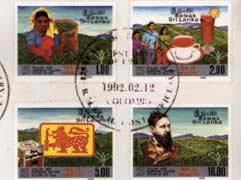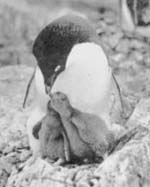 |
 1st March 1998 |
Front Page| |
|
|
|
|||
Pen PalsName: J.B.Rohan Anurudha Name: Harshanee Abeygunawardhana Name: Nayani Ranasinghe
Fazla Meyen of Siri Dhamma Mawatha Colombo 10 writes..... "I am a 13 year old stamp collector. I am also a reader of the Junior Times. I was very happy when the magazine decided to have a Stamp Corner. I am sure all the Sri Lankan Stamp collectors feel the same. "I would appreciate it very much if you could tell me how to register myself at the Philatelic Bureau since I am interested in it." Another reader, H.M.A. Bandara from Ankelipitiya, Thalatuoya too wants to know how to register at the Philatelic Bureau. Uncle D.C.R says You can register yourself by writing to Director, Philatelic Bureau, General Post Office, Colombo 1. Send a cheque or a money order for Rs 100 or 200 so that he can start sending you the new issues. Indicate the number of First Day Covers you need of each new issue and whether you need stamps too. You can also get past issues, if they are available. The Bureau will keep an account and let you know when more money is needed. Help:
King TeaThey still call it Ceylon tea, and it's one
of the finest brews in the world. The plantations of Nuwara Eliya, with
manicured bushes carpeting misty hills and vales, are a tourist attraction.
This extract is from a recent issue of Time magazine in a feature titled 'An Island of Infinite Variety' to mark the Golden Jubilee of our Independence. Tea, which is the number one export product among plantation crops, has a history of over one and a half centuries in Sri Lanka since the first plant was planted at the Royal Botanical Gardens in Peradeniya in 1839. G.H.K. Thwaites, Director of the Peradeniya Gardens from 1849 to 1880 had even advertised tea seeds for sale and advocated its cultivation but many had not taken much notice since they were all involved with coffee cultivation. When disease devastated the coffee plantations in the mid 19th century,
a planter by the name of James Taylor (1835-1892), a Scotsman was adventurous
enough to plant 21 acres of tea seeds on a Taylor wrote about the early days thus:"The credit for starting the Tea Industry in Ceylon as well as cinchona planting, belongs to Messrs. Harrison and Martin Leake, trading as Keir Dundas & Co who were my employers and proprietors of Loolecondera. I learned manufacture mainly from others and from reading, but it took a lot of experimenting before I was successful. About the time we began planting China tea from seed supplied by Peradeniya Gardens, Mr. Noble, an Indian tea planter from Cachar passed through and I got him to show me the way to pluck and wither and roll tea. Afterwards when Mr. Jenkins of the Ceylon Company, an old Assam planter, came to the country, he called on me and I made the first batch of tea under his direction". In 1883 the first tea auction took place in the offices of Sommerville & Company Limited, a well known firm of tea brokers who are in business to this day. Ever since the first auction held on 26th July 1883, auctions have been a regular feature in Colombo for the sale of our tea. It is the most important marketing channel for the sale of Sri Lanka's most important agricultural product. The first time tea was used in a stamp was on 15 May 1954 when an 85 cent stamp, one of a set of six pictorial stamps featured a tea plantation, a plucker and a factory. It was reissued in 1958 as a Re. 1 stamp. Tea pluckers on an estate were featured on one of the four stamps issued on 14 March 1983 to mark Commonwealth day. Over the years, the Colombo Tea Auction grew to be the largest tea auction in the world and by the time it completed 100 years, it had surpassed in size even the prestigious London Tea Auction. The centennial year for the Colombo Tea Auctions was commemorated by the issue of four stamps on January 1, 1984. They carried pictures of a tea factory (Re. 1), the export market (Rs. 2), a tea plucker (Rs. 3) and tea auction (Rs.10). 125 years of the tea industry in Sri Lanka was celebrated with the release of four stamps on February 2, 1992. The nimble fingers of the estate lass plucking 'two leaves and a bud' (Re. 1 stamp), tea as a family health drink (Rs. 2), the lion symbol used frequently to identify Sri Lankan tea (Rs. 5) and James Taylor, the father of Ceylon tea in the backdrop of a tea plantation (Rs. 10) were featured. Tea continues to be our biggest foreign exchange earner among the three main plantation crops - tea, rubber and coconut. Tea production in Sri Lanka set a new record in 1996 with an output of 258 million kilograms. Exports reached an all time high of 244 million kgs. in 1996, second only to Kenya (248 million kgs). Russia and the Middle east are the main buyers of our tea.
Caring for the youngThe reason for parental care is to make sure that at least some of the offspring survive to maturity. Animals do not all devote the same amount of time and attention to their care of the young. The amount of care given to the young depends on many things. Animals that have a short life-span may spend little or no time looking after their young. Also, the number of young produced can affect the amount of parental care. Animals that produce lots of offspring each season will spend less time looking after them. Many or few Animals may abandon their eggs at different stages of development. The eggs of many marine and freshwater animals are left to be fertilized and to develop without any care from the parents. They may produce many thousands of eggs during each breeding season.
Most of the young will be The better developed the young are when they are born (or hatch), the greater their chances of survival. The animals that produce only a few offspring will be able to devote more attention to each of them. The parents can collect only a certain amount of food. The fewer offspring there are to feed, the more food each of them will get. Parental care over a long time may reduce the number of young that will be produced. However, more of the offspring are likely to survive and reproduce. The environment may also influence the number of offspring produced. In cold, harsh climates where food is more difficult to find, animals may only have one or very few offspring each season. They need a lot of care, but develop quickly. In some species of fish the male plays an important part in looking after and protecting the eggs. The male stickleback builds a nest in which the female will lay her eggs. After fertilization the male guards them. The male seahorse also looks after his young. The female lays her eggs into the male's brood pouch where they develop. When the young are ready, the pouch opens and they swim out. Many animals that have evolved complex social life-styles take great care in raising their young. The female Nile crocodile lays her eggs in a hole she has dug in the sand well above the banks of the river. The eggs will develop at a more or less constant temperature buried in the sand. When they are ready to hatch the young crocodiles will call from inside the eggs. Their calls are loud enough to be heard by their parents, often a few metres away. The mother digs away the sand to get out the hatching babies. Both parents will pick them up very gently in their huge mouths and carry them down to the nursery area in the river. Nile crocodile families may stay together for as long as a year. The way the young behave usually makes the parents provide either food or care. Most baby birds open their beaks very wide and "cry". This behaviour stimulates the parents to feed them. Colonies Some groups of insects like wasps, bees and ants have evolved a very complex social structure. They live in colonies. All the members of the colony are usually the offspring of a single giant "queen" and her mate. Their eggs develop into infertile "workers" Some workers build up and clean the nest. Others take care of the eggs and the grubs. Larger animals, for example many mammals, spend a lot of time feeding and caring for their young. They also teach them to look after themselves. The young of many mammals are born blind and helpless. They depend on their mothers to provide them with milk and protection from danger. Marsupial mammals like kangaroos have a pouch in which their babies develop. The "joey" grows inside the pouch for several months suckling its mother's milk. For a short while after it leaves the pouch it may jump back in at the first sign of danger. |
|||
|
Return to Mirror Magazine Contents
Front Page| News/Comment| Editorial/Opinion| Business| Plus |Sports |
|||
|
Please send your comments and suggestions on this web site to The Sunday Times or to Information Laboratories (Pvt.) Ltd. |
|||

 Even
more colourful is the tea-tasting done in Colombo. Tasters sip 600 mouthfuls
a day: they then spit it out - judging whether the teas are 'smoky', 'fruity'
or 'weathery'. True experts can tell in a sip exactly where a leaf was
grown.
Even
more colourful is the tea-tasting done in Colombo. Tasters sip 600 mouthfuls
a day: they then spit it out - judging whether the teas are 'smoky', 'fruity'
or 'weathery'. True experts can tell in a sip exactly where a leaf was
grown. commercial
basis. That was in 1867 in Loolecondera Estate, Deltota where he was superintendent.
The venture soon proved to be a tremendous success and today over 475,000
acres (193,000 hectares) are under cultivation.
commercial
basis. That was in 1867 in Loolecondera Estate, Deltota where he was superintendent.
The venture soon proved to be a tremendous success and today over 475,000
acres (193,000 hectares) are under cultivation. eaten
by predators. Those that are left will have to compete to survive. But,
producing vast numbers of offspring ensures that at least a few will survive.
eaten
by predators. Those that are left will have to compete to survive. But,
producing vast numbers of offspring ensures that at least a few will survive.

